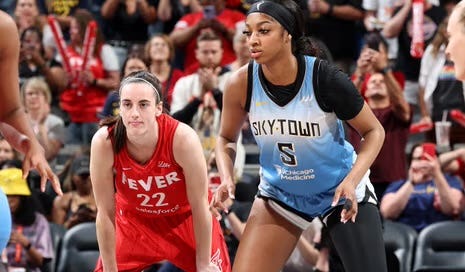The Vanguard of a New Era : Caitlin Clark & Angel Reese
Women's basketball is undergoing a transformative era, driven by the remarkable talents and artistry of players like Caitlin Clark and Angel Reese. These athletes are not merely stars of the game but are redefining what it means to be exceptional in women's sports. Often compared to the legendary rivalry of Larry Bird and Magic Johnson, Clark and Reese each bring a unique style and presence to the court, weaving a narrative as compelling as a carefully crafted painting or an intricate dance. Their rivalry not only elevates the competition but also highlights their individual brilliance, turning each game into an extraordinary showcase of skill.
To begin with, Caitlin Clark approaches basketball with the precision and creativity of a pointillist painter. Her style mirrors the careful exactness of Georges Seurat, particularly in his magnum opus "A Sunday Afternoon on the Island of La Grande Jatte," where each dot of color contributes to a stunning whole. Similarly, every three-pointer and assist by Clark is like a carefully placed dot, contributing to a grand vision on the court. Her shooting form and expansive court vision create a scene of brilliance with every play. Clark’s game epitomizes the detailed and expressive athleticism described in David Epstein's "The Sports Gene: Inside the Science of Extraordinary Athletic Performance," where every movement and decision is a component of a larger, scientifically-informed masterpiece.
Moreover, Clark's command of the game, characterized by sureness
and elegance, sets her apart from her contemporaries. Her basketball intellect, combined with her physical skills, makes her a true maestro on the hardwood. Much like Seurat's paintings, which reveal deeper complexities upon closer examination, Clark’s gameplay offers new insights with every replay. Her strategic acumen, capable of dissecting defenses and orchestrating her team’s offense, parallels the way Seurat choreographed movement and emotion in his art.
On the other hand, Angel Reese embodies the bold strokes and raw emotional intensity of an expressionist painter. Her game is imbued with passion and power, reminiscent of the works of Jackson Pollock or Edvard Munch, where emotion drives form. Reese’s presence on the court is a dynamic performance, evocative of Martha Graham's transformative choreography. Her ability to dominate the paint and seamlessly transition between defense and offense creates a visual and emotional feast, each play charged with the intensity and vigor of an expressionist chef d'oeuvre.
Furthermore, Reese's style of play is a testament to her physicality and emotional depth. Every rebound, block, and drive to the basket is executed with a fervor that commands attention. Just as Pollock's splashes of paint pulse with movement and emotion, Reese's game is inculcated with the ardency of her competitive spirit. Her dominance in the paint, where she outmaneuvers and overpowers her opponents, changes the expectations for female athletes, positioning her as a force of nature.
In addition, the broader societal contexts in which Clark and Reese compete further enrich their narratives. Caitlin Clark’s precise and calculated game mirrors the sophisticated beauty and dynamic movement captured in Georges Seurat's works. Meanwhile, Angel Reese’s bold, expressive style challenges and reshapes traditional stories in women's basketball, as discussed in "Playing with the Boys: Why Separate is Not Equal in Sports" by Eileen McDonagh and Laura Pappano. This analysis underscores the significance of recognizing and valuing the contributions of female athletes equally alongside their male counterparts.
Appreciating their unique talents without reducing them to mere comparisons allows us to understand their multifaceted contributions. Clark’s pointillist precision and Reese’s expressionist passion are reshaping women’s basketball, creating a ballet of brilliance that inspires future generations. Indeed, their impact transcends the basketball court, resonating with broader societal issues and contributing to ongoing dialogues about race, gender, and equality in sports.
Moreover, their influence extends into cultural and social realms, where they serve as role models for young athletes and advocates for gender equality in sports. Clark’s and Reese’s performances challenge entrenched biases and pave the way for future generations to pursue their dreams unencumbered by outdated stereotypes. Their stories remind us that sports are not merely about competition but also about community, collaboration, and the collective joy of human achievement.
In celebrating Clark and Reese, we move beyond simplistic comparisons and acknowledge the depth and complexity of their contributions. They are at the forefront of a new era in women’s basketball, where every play is a brushstroke, every game a dance, and every season an evolving artwork. Their legacies are still unfolding, and their stories continue to inspire, one precise dot and bold stroke at a time.
By recognizing their artistic approach to basketball, we can appreciate the beauty and intelligence they bring to the game. Their journeys are not just about breaking records but about breaking barriers, expanding the possibilities in women's sports. As we look to the future, Caitlin Clark and Angel Reese's legacies will undoubtedly continue to shine, guiding and inspiring the next generation of athletes to reach for the stars and create their own masterworks on the basketball canvas.



